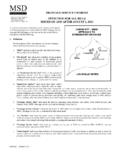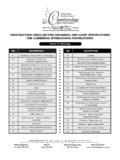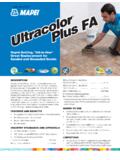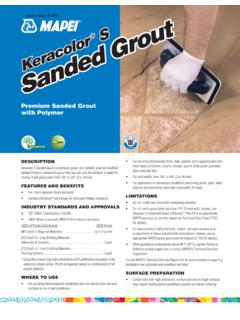Transcription of CHESAPEAKE BAY EXCEPTION GUIDELINES & …
1 Engineering and Resource Protection Division 101-E Mounts Bay Road Williamsburg, VA 23185 757-253-6670 COUNTY OF JAMES CITY, VIRGINIA CHESAPEAKE BAY EXCEPTION GUIDELINES & SPECIFICATIONS NAME OF DOCUMENT PERVIOUS PAVER BLOCK SYSTEMS AS PART OF CHESAPEAKE BAY EXCEPTIONS (RESIDENTIAL APPLICATIONS) This guideline and specification is intended to be used by applicants, designers, or plan preparer s who intend to utilize pervious paver block systems as a mitigation measure for Bay Act CHESAPEAKE Bay EXCEPTION purposes. It can also be used by the general public to educate themselves about the use, function, and benefits of these types of systems.
2 This information is intended for residential purposes only, not larger scale site plan applications. It only applies to pervious paver block systems used for mitigation purposes and is not meant as a requirement for those who choose to use traditional hardscape surfaces for residential features such as driveways, patios, and walkways. The last page of this packet is required to be filled out and submitted to the County if pervious paver block systems are being used for mitigation purposes for residential CHESAPEAKE Bay EXCEPTION applications, especially if placement is proposed within a defined Resource Protection Area (RPA).
3 Importance of Infiltration - From a regulatory aspect, all of James City County is in a Resource Management Area (RMA). Performance standards of the CHESAPEAKE Bay Act require land disturbance to be limited to only the area necessary for proposed use or development, for existing vegetation to be preserved to the maximum extent possible consistent with the proposed use or development, and impervious cover must be minimized to promote the infiltration of stormwater into the ground. From a scientific aspect, the effects of land development on the hydrologic water cycle are well documented.
4 In a well vegetated forest or meadow, a significant amount of rainfall is collectively taken up by evaporation, transpiration, absorption, and by the percolation and infiltration of runoff through and into the soil. Water vertically flows through the soil. Some is stored in the soil itself or it continues through until it reaches water tables or, because of topography, it flows laterally through the soil and emerges as springs or seeps. These springs or seeps provide base flow for our local streams and wetlands. In forest or meadow conditions, a very small amount of rainfall becomes surface runoff.
5 In addition to evaporation and transpiration, natural ground cover and leaf litter provides resistance against soil erosion. Leaf litter and organic matter decompose and become nutrients for adjacent existing vegetation and biological organisms. Clearing the land surface of natural vegetation and/or adding impervious cover (roads, buildings, parking lots, roofs, etc.) impacts the hydrologic cycle in several ways. It removes forest and meadow areas which subsequently result in the loss of the evaporation and transpiration components of the cycle. The soils are now exposed which increases surface erosion.
6 During clearing and grading processes, natural soils are altered in a way by which percolation and infiltration aspects of the soil are reduced. Also, as natural vegetation is replaced with impervious surfaces, drainage patterns are altered and percolation and infiltration (groundwater recharge) is dramatically decreased and the amount of surface runoff increases. The increase in surface runoff results in higher potential for surface soil erosion, downstream flooding, and erosion in downstream natural receiving waterways. Surface or channel erosion results in sediments being carried downstream to affect other natural waterways such as lakes, rivers and the bay.
7 In addition natural forests and meadows and their associated soil profiles have, in a collective ecological fashion, natural pollutant removal mechanisms that are significantly reduced or lost due to land development activities. JAMES CITY COUNTY - ENGINEERING AND RESOURCE PROTECTION CHESAPEAKE BAY EXCEPTION GUIDELINES & SPECIFICATIONS CBE_perviouspavers Page 2 revised 4/2012 General - permeable or pervious paver block systems, or managed permeable paver systems , are viewed as a common alternative to traditional types of hardscaping such as concrete, brick, mortar, or asphalt.
8 These systems must be specifically designed, installed and maintained properly in order to obtain distinct mitigation credit for CHESAPEAKE Bay EXCEPTION purposes. If not properly designed, installed and maintained appropriately as a pervious or somewhat pervious system, then these systems are considered as aesthetic features and are considered as impervious cover, just like concrete or brick. Background - pervious paver block systems have been available for many years and have been used primarily as aesthetic treatments for parking areas and low volume roadways. Other traditional uses include applications for overflow parking, emergency access or fire lanes, pedestrian trails, golf cart lanes and boat launch areas.
9 In recent times, these systems have been used more and more for residential home purposes. Residential applications include patios, driveways, sidewalks, walkways, pathways, landings, pool-side perimeters, erosion control, shoreline stabilization, gardening and general landscaping. A typical 10 ft. by 10 ft. or 100 square feet traditional concrete or brick patio can generate about 9 cubic feet of runoff volume (about 65 gallons) during a 1-inch rainfall storm event. This is compared to little or no runoff if the same area was forest, meadow or even high lawn grass. There is multitude of manufacturers in the market who offer pervious paver block systems each with different color, style, configurations and material type.
10 Some manufacturer s pitch the term pervious pavers when indeed the actual block structure itself is not pervious at all and the joint or foundation structure may or may not be. Use as a Mitigation Tool - In order for pervious paver block systems to achieve water quality benefits, there must be a properly engineered or designed system that allows for rainfall and surface runoff to penetrate through the paver blocks or joint network into underlying layers of sand or larger stone, such as AASHTO #57 stone. In addition, soils underlying the sand or stone base must have acceptable infiltration characteristics, generally with an infiltration rate at least of one-half ( ) inch per hour.









